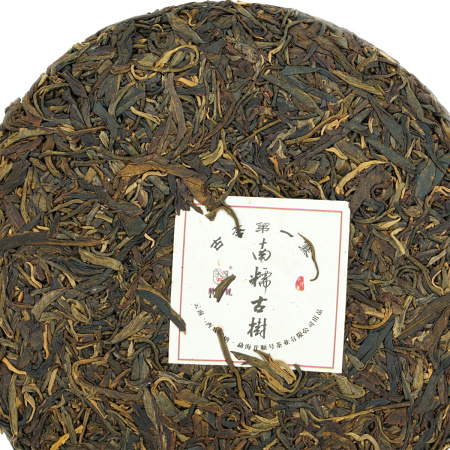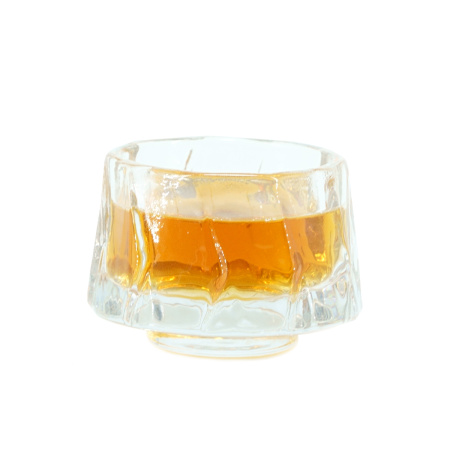-
0 Saturation
-
0 Aftertaste
-
0 Aroma
-
0 Effect
-
0 Balance
-
0 Body
Шэн Пуэр 2013 г. "Многовековые деревья деревни Ди И гор Нань Но" марки "Кайшуньхао": Сокровище из глубины веков
Шэн 2013 года с древних деревьев из деревни Ди И в горах Нань Но (кит. 南糯古树茶第一寨, пиньинь Nán nuò gǔ shù chá dì yī zhài) – это не просто название чая, это история, запечатленная в каждой листочке. Шэн пуэр, созданный из сырья многовековых чайных деревьев Наньно, горной области Юньнань, является настоящим шедевром чайного искусства.
История и происхождение
Деревня Ди И, расположенная в сердце гор Наньно, славится своими древними чайными деревьями, возраст которых достигает нескольких сотен лет. Листья, собранные с этих деревьев, обладают уникальным составом и придают чаю неповторимый вкус и аромат. Компания "Кайшуньхао", известная своим бережным отношением к традициям и высоким качеством продукции, создала этот пуэр, чтобы сохранить и передать будущим поколениям богатство вкуса и истории этого особенного региона.
Вкус и аромат
Шэн пуэр "Многовековые деревья деревни Ди И гор Нань Но" обладает глубоким и сложным вкусом. В нем сочетаются сладкие фруктовые ноты, древесные оттенки и легкая минеральность. Аромат чая насыщенный, с выраженными цветочными и медовыми нотками. С каждым новым проливом раскрываются новые грани вкуса, позволяя наслаждаться чаем долгое время.
Свойства чая
- Богат антиоксидантами: Шэн пуэр помогает защитить организм от свободных радикалов и замедлить процессы старения.
- Улучшает пищеварение: Способствует нормализации работы желудочно-кишечного тракта и ускоряет метаболизм.
- Укрепляет иммунитет: Повышает сопротивляемость организма к различным заболеваниям.
- Тонизирует организм: Дарит бодрость и энергию без перевозбуждения.
Как заваривать
Для того чтобы раскрыть все богатство вкуса и аромата этого чая, рекомендуется использовать традиционную китайскую посуду для заваривания пуэра. Чай заваривается горячей водой (около 95 градусов Цельсия) в несколько заходов. Каждый последующий пролив раскрывает новые грани вкуса и аромата чая.
Почему стоит попробовать этот чай?
- Уникальный вкус: Сочетание сладких фруктовых и древесных нот создает неповторимый вкусовой профиль.
- Высокое качество: Чай произведен из высококачественного сырья и обладает прекрасными органолептическими свойствами.
- История и традиции: Этот чай – это часть богатой истории китайского чаеводства.
- Полезные свойства: Шэн пуэр обладает рядом полезных свойств, которые благотворно влияют на организм.
Шэн пуэр "Многовековые деревья деревни Ди И гор Нань Но" 2013 г. – это не просто напиток, это путешествие в мир китайской чайной культуры. Этот чай станет прекрасным подарком для себя или близких людей.
|
Name in Chinese
|
2013 |
|
Pinyin
|
2013 Nán nuò gǔ shù chá dì yī zhài |
|
Translation
|
2013 tea from ancient trees from Di Yi village in the Nan No Mountains |
|
Country
|
China |
|
District
|
Sishuangbanna Dai Autonomous Prefecture |
|
Provinces
|
Yunnan (云南) |
|
Habitat
|
Наньно (南糯, nánnuò) |
|
Manufacturer
|
Кайшуньхао (开顺号) |
|
Raw material production date
|
28.03.2013 |
|
Year of pressing
|
2013 |
|
Pressing form
|
Bing Cha (Cake Tea) |
- Reviews
- Vkontakte
Pu-erh is one of the most unique types of tea, which only gets better with age. Many people, when they first encounter this tea, wondered: why is pu-erh more often found in pressed form (cakes, bricks, tochas), and not in loose form? The reasons for this are related to both history and the practical aspects of storing and fermenting tea. Despite modern technologies that allow the production of loose pu-erh, the shape of pressed cakes remains unchanged. And pu-erh is more often found on sale in pressed form, for example, in the form of cakes or bricks, and loose pu-erh is less common. We will talk about the reasons for pressing pu-erh into cakes in this article.
Puer is a unique Chinese tea that is distinguished by its depth of taste, complexity of aromas and versatility of aftertaste. Its taste characteristics are formed under the influence of many factors, from growing conditions to the brewing method. Let's look at the main ones.
























































































